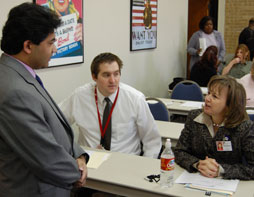By Keisha McDuffie/ne news editor

Research reveals patients treated for depression are often coinciding diagnosed with another mental illnesses or psychiatric diagnosis. In addition to mental illnesses and psychiatric diagnosis, nearly half of all mentally ill patients seeking treatment are alcohol or drug dependent, a medical doctor said recently.
Dr. Syed M.M. Quadri, of Harris Methodist Springwood Hospital, and two other licensed counselors from Harris, presented Co-occurring Disorders Throughout the Lifespan, sponsored by the NE mental health department March 1.
The seminar split the stages of an individual’s life into three parts: “ADHD and Depression in Adolescence,” “Depression and Substance Abuse in Adults” and “Substance Abuse in the Geriatrics Population.”
Quadri said two of the most common disorders among children today are attention-deficit hyperactive disorder and major depressive disorder. ADHD and MDD are also the two most common co-occurring psychiatric disorders.
When such disorders are not properly treated in adolescents, Quadri said, the result can often have a domino effect. Thus, he said, it is vital for mental disorders to be addressed, diagnosed and treated.
Quadri said 60-70 percent of children with ADHD will continue to have symptoms as an adult, but only
10 percent are currently diagnosed and treated.
MDD is the leading cause of disability in the 15-44 age bracket in the United States, according to a National Institute of Mental Health study. Each MDD case requires $1,000-$2,500 for direct care cost alone.
Those suffering from ADHD or MDD are more likely to have relationship problems, legal issues, higher dropout rates, poor job performance, substance use and a higher percent of suicides, Quadri said.
According to the American Academy of Child and Adolescent Psychiatry, suicide is the third leading cause of death for 15- to 24-year-olds, and the sixth leading cause of death in 5- to 14-year-olds.
Depression and mental illness also affect the economy in several ways. The estimated cost of depression in 2000, was $83.1 billion, of which $26.1 billion was for direct care costs.
Ross Teemont, program manager, licensed social worker and counselor at Springwood Hospital, presented an in-depth look at adults with co-occurring psychiatric and substance use disorders.
Teemont described the combination of bipolar disorder and SUD as the most complex highly co-morbid and potentially lethal among the major psychiatric disorders.
Statistics show 56.1 percent of all individuals diagnosed with bipolar disorder have a co-occurring substance use disorder. Teemont said 11 percent of patients with generalized anxiety disorder have SUD, excluding alcohol.
“ These patients have a tendency to self medicate,” he said.
Eight to 52 percent of alcohol dependent patients also have symptoms of GAD.
Reports concluded 17-45 percent of adults with ADHD use alcohol and up to 50 percent use drugs.
Treatment works when properly diagnosed and patients take the correct dosage of their medication, Teemont said.
“ Medication is one of the problems. Family doctors are prescribing one antidepressant; a psychiatrist is prescribing an additional SSI or anti-psychotic medication, and so often these are the cases in which the patient is still using illegal substances,” he said. “The results can be very dangerous.”
With family support and patient cooperation, treatment is not impossible, Teemont said, stressing the importance of non-pharmacologic treatment.
“ So many of the common medications used are highly addictive,” he said. “Treatment for depression with medication alone does not improve SUD outcome.”
Cognitive behavioral therapy, life-skill training, 12-step programs, community support groups and relaxation exercises are all ways to maximize a patient’s treatment process as well as patient medication compliance. And if a patient does relapse, careful monitoring of toxicity levels of medications is necessary.
Barbara Alderate, a licensed counselor and social worker, concluded the presentation with “Dual Diagnosis in the Geriatric Client.”
Because of age, lack of awareness and presence of dementia or other medical conditions, these patients are the most under-diagnosed, Alderate said.
The elderly are at higher risk for anxiety and mood disorders in general. Phobias also affect a large percentage of the older population whether a fear of driving or of being alone. Panic attacks and depression are also common among the geriatric community, Alderate said.
Depression often occurs after a spouse has died or when a serious illness (cancer, pneumonia) is discovered. Becoming suddenly isolated, feeling alone or not having the ability to perform normal activities can also trigger depression in the elderly.
“ We also mistake depression in the elderly to be a natural process,” she said.
“ This does not mean these people do not need or that they won’t benefit from [depression] medication.”
Alderate said alcohol abuse usually begins in middle or early adulthood and can be associated with medical illnesses or an onset related to pain.
Anti-anxiety, opiate medications, sedatives or benzodiazepines as well as continued use of previous medications are commonly abused substances in this age group.
“ There is more of an issue with the misuse of these medications than with the abuse of them,” she said.
Alderate said each treatment plan is different from individual to individual and should be determined by the family or the provider.
The financial resources and the availability or limitation of transportation need to be identified. The needs of both disorders must be addressed, and a patient’s willingness is a determining factor in the treatment process, Alderate said.
The first step in motivating these patients to want change is to establish a rapport with a nonjudgmental approach, Alderate said. A shameful or authoritative manner may come off as if the provider is attempting to treat the patient like a child.
Determining the patient’s discrepancy among values, goals and behaviors is next. Education on mental health, substance use effects and interaction between substance and mood is another way to help motivate the patient.
Alderate said identifying the consequences aloud or in writing will help make them more real, as will identifying what directions the patient can go.
Contacting a 12-step program in the neighborhood and making lifestyle changes that promote abstinence are good ways to show concern, Alderate said.
The sooner any mental illness is diagnosed and treated can only make for less stress and hardships later, Alderate said.
Another positive result of early detection is preventing an adolescent from developing a substance use disorder in the future.






























